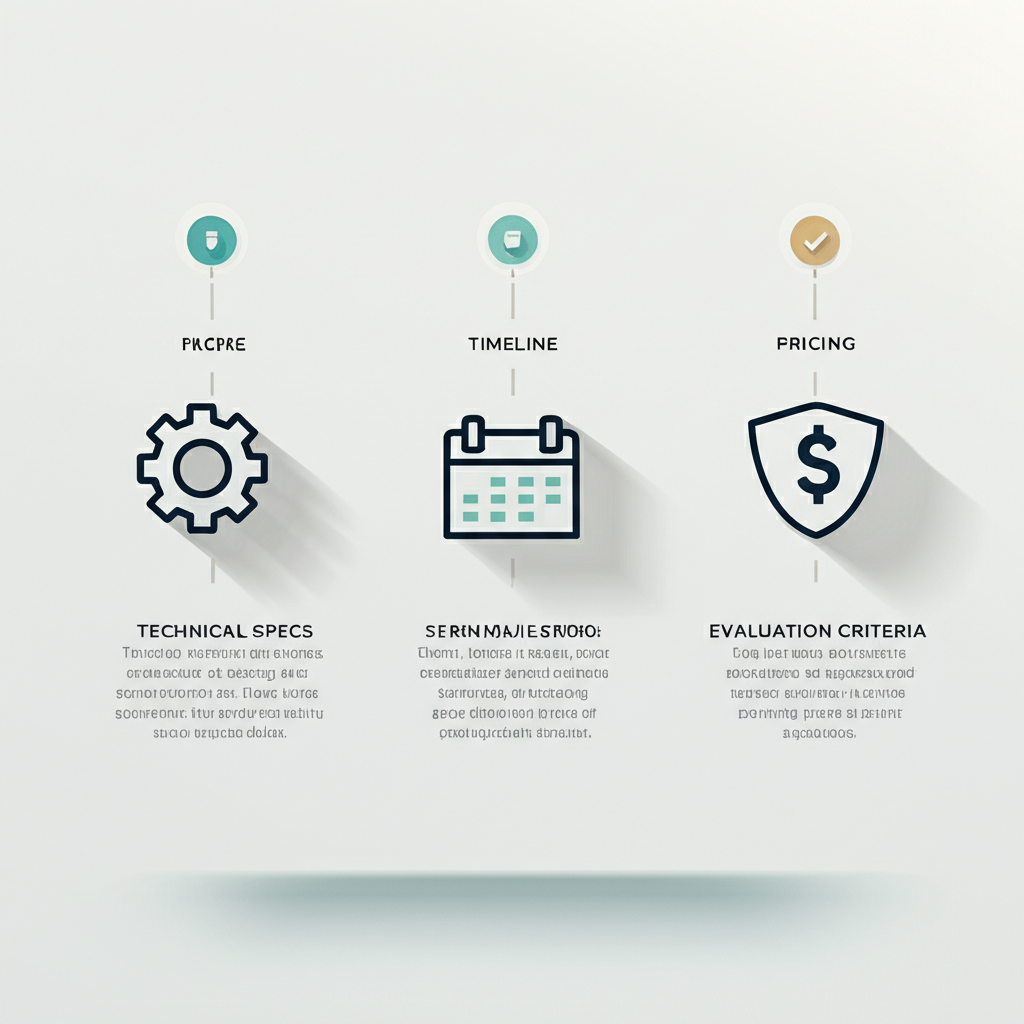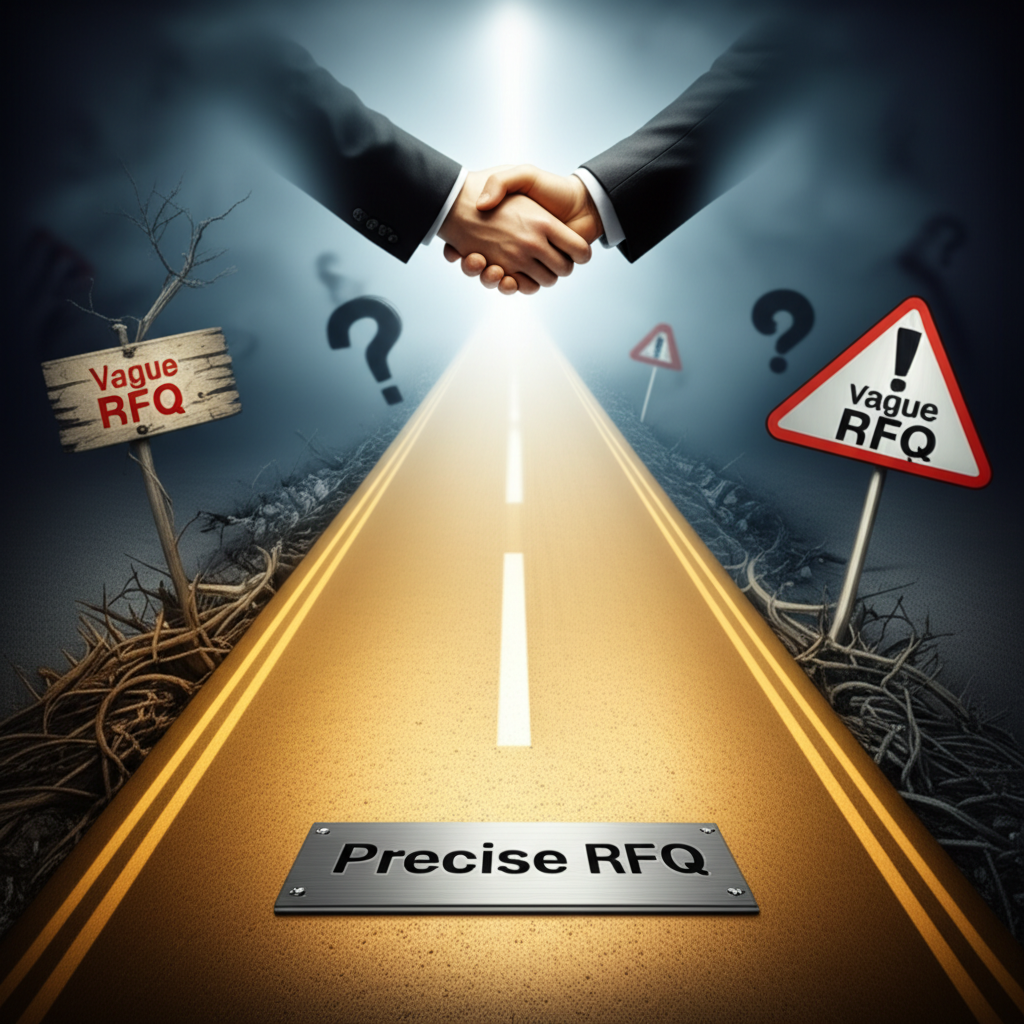How to Write an Effective RFQ for Forging Services

TL;DR
Writing an effective Request for Quotation (RFQ) for forging services requires a detailed document that leaves no room for ambiguity. To receive accurate and comparable quotes, you must clearly define your project scope, provide precise technical specifications for materials and tolerances, outline your timeline, and establish clear evaluation criteria. This precision ensures potential suppliers understand exactly what you need, minimizing costly errors and delays.
The Essential Components of a Forging RFQ
A well-structured RFQ is the foundation of a successful procurement process. It acts as a clear and comprehensive brief for potential suppliers, ensuring that the quotes you receive are relevant, accurate, and easy to compare. For a specialized process like forging, detail is paramount. A vague RFQ leads to vague quotes, wasted time, and potential budget overruns. Before you begin writing, it's essential to understand the core sections that form the backbone of your document.
Each component serves a distinct purpose, from introducing your company's needs to defining the contractual obligations. As detailed in guides from procurement experts, a thorough RFQ should provide vendors with all the information they need to submit a competitive bid. This includes not just what you want to be made, but also the context of the project, your quality expectations, and the logistical requirements. Think of it as a blueprint for your partnership with the supplier.
To ensure clarity and completeness, your RFQ for forging services should include these fundamental elements:
- Business and Project Overview: Start with a brief introduction to your company and the project. Explain the purpose of the forged parts and where they will be used. This context helps suppliers understand the application and importance of quality.
- Detailed Specifications: This is the most critical section for forging. It must go beyond simple dimensions. Include technical drawings, CAD models, material requirements, and more. (This will be covered in greater detail in a dedicated section below).
- Quantities and Production Volume: Specify the required quantity for the initial order, as well as forecasted annual volumes. This information is crucial for suppliers to calculate tooling costs, material purchasing, and pricing tiers.
- Timeline and Key Milestones: Provide a clear schedule. Include the deadline for quote submission, the date for supplier selection, the expected timeline for tooling creation, first article inspection (FAI), and the start of mass production.
- Pricing Table: Do not leave the pricing format open to interpretation. Provide a standardized template that suppliers must complete. This should break down costs for tooling, per-part price at different volume levels, and any secondary operations. This makes comparing bids an apples-to-apples process, as recommended by resources like Wrike.
- Evaluation Criteria: Be transparent about how you will choose the winning bid. Is cost the primary factor, or are you weighing lead time, quality certifications (e.g., IATF 16949), and technical capability more heavily? This manages supplier expectations and ensures a fair process.
- Terms and Conditions: Include your standard contractual terms covering payment schedules, warranties, intellectual property rights, and confidentiality agreements (NDAs).
Step-by-Step Guide to Drafting Your RFQ for Forging
Transforming your requirements into a formal document follows a logical sequence. A methodical approach, as outlined in processes by procurement platforms like Sievo, ensures no critical detail is missed. By following these steps, you can create a professional and effective RFQ that attracts high-quality forging suppliers and sets your project up for success from the very beginning.
- Preparation and Internal Alignment: Before writing a single word, gather all necessary information internally. Collaborate with your engineering, quality, and finance teams to define every requirement. This includes finalizing technical drawings, material specifications, and budget constraints. This initial preparation is the most critical step to prevent scope changes later on.
- Identify and Vet Potential Suppliers: Research and compile a list of potential forging suppliers. You can have an open bid, but for specialized services, an invited bid to pre-qualified vendors is often more efficient. Look for suppliers with experience in your industry. For example, if you need automotive components, a supplier with IATF 16949 certification is crucial. For those seeking robust solutions in this sector, exploring providers of custom forging services from Shaoyi Metal Technology can be a valuable step, as they specialize in certified hot forging for the automotive industry.
- Draft the RFQ Document: Using the components listed in the previous section, write the full RFQ. Be clear, concise, and professional. Use standardized templates to ensure consistency, especially for the pricing section. Have a colleague or manager review the document for clarity and completeness before it is sent out.
- Distribute the RFQ and Manage Communications: Send the complete RFQ package to your selected list of suppliers. Establish a single point of contact within your organization to handle all questions. It is vital to ensure that if one supplier asks a question, the answer is distributed to all bidders to maintain a fair and transparent process.
- Receive and Analyze Responses: As quotes arrive, log them and confirm receipt. Once the submission deadline passes, begin your evaluation. Use the pre-defined scoring criteria to objectively compare the bids. The standardized pricing table you provided will make the financial comparison straightforward.
- Select the Supplier and Award the Contract: Based on your analysis, select the supplier that offers the best overall value. This may not always be the lowest price. Notify the winning bidder and proceed to finalize the contract. It is also professional courtesy to inform the unsuccessful bidders of your decision. This maintains good relationships for future projects.
Crucial Technical Specifications for Forging Services
This section is where an RFQ for forging services distinguishes itself from a general procurement document. The precision of your technical details directly impacts the quality, cost, and performance of the final product. Generic descriptions are not enough; you must provide a comprehensive technical package that allows a forger to understand exactly what is required. Leaving these details ambiguous is the most common cause of inaccurate quotes and production failures.
A detailed specification sheet demonstrates your company's expertise and commitment to quality, attracting more capable and professional suppliers. This level of detail minimizes the need for back-and-forth communication and allows suppliers to quote with confidence. Ensure your RFQ includes the following specific categories of information.
Material Requirements
Simply stating "steel" is insufficient. Be explicit about the material to be used.
- Specific Grade: List the exact alloy grade (e.g., AISI 4140, ASTM A36, Aluminum 6061-T6).
- Certifications: Specify if material certifications or certificates of conformity are required with the shipment.
- Origin Requirements: If the material must be sourced from a specific country or region, state this clearly.
Tolerances, Finishing, and Secondary Operations
The forging process creates a near-net shape, but post-forging operations are often necessary. Your RFQ must detail these requirements to get an all-inclusive quote.
- Dimensional Tolerances: Provide a fully dimensioned drawing, including acceptable tolerances for all critical features. Reference industry standards (e.g., ISO, ANSI) where applicable.
- Surface Finish: Specify the required surface roughness (e.g., Ra value) and any post-forging surface treatments like shot blasting or painting.
- Secondary Machining: If the part requires drilling, tapping, milling, or turning after forging, provide separate machining drawings that clearly indicate these operations.
- Heat Treatment: If the part needs to be hardened, tempered, annealed, or normalized, specify the exact process and the required final hardness (e.g., HRC 38-42).
Inspection and Quality Assurance
Clearly define how you will verify the quality of the parts. This ensures the supplier knows your expectations from the start.
- Inspection Criteria: State the required inspection methods. This can include First Article Inspection (FAI) reports, Production Part Approval Process (PPAP) submissions, and ongoing quality checks.
- Non-Destructive Testing (NDT): Specify if NDT methods like Magnetic Particle Inspection (MPI), Ultrasonic Testing (UT), or X-ray inspection are required to check for internal defects.
- Packaging and Shipping: Describe how parts should be packaged to prevent damage during transit, including any specific rust prevention measures or pallet requirements.

Avoiding Common RFQ Mistakes in Forging Procurement
Even a well-intentioned RFQ can fail if it falls into common traps. These mistakes often lead to inaccurate pricing, extended lead times, and friction with suppliers. According to industry analysis, many of these errors stem from incomplete data or vague requirements. By being aware of these pitfalls, you can create a document that is not only comprehensive but also practical and effective, fostering better relationships with your supply chain partners.
The goal is to eliminate guesswork for the supplier. Every question they have to ask is a delay in the process and an opportunity for misunderstanding. Proactively addressing these common issues in your RFQ document demonstrates professionalism and helps ensure the procurement process runs smoothly from start to finish. Focus on avoiding these critical errors.
- Incomplete Technical Data Package: One of the most frequent mistakes is sending an RFQ with missing or outdated drawings, no 3D CAD models, or a lack of detail on tolerances and surface finishes. Solution: Always include a complete technical data package with up-to-date, revision-controlled 2D drawings and 3D models. Clearly specify all material, finishing, and inspection requirements on the drawing itself.
- Vague Quantity and Delivery Needs: Stating "various quantities" or "delivery ASAP" is not helpful. Suppliers need concrete numbers to quote accurately and plan production. Solution: Provide specific order quantities for the initial batch and a realistic annual forecast. Include a clear delivery schedule with specific dates or a defined window (e.g., "Q2 2026").
- Ignoring Post-Forging Processes: Many buyers focus solely on the forging itself and forget to detail essential secondary operations like machining, heat treatment, or plating. This results in incomplete quotes that don't reflect the total cost. Solution: Create a checklist of all required operations from raw material to finished part. Ensure each step is clearly defined in the technical specifications section of the RFQ.
- No Standardized Pricing Format: Allowing suppliers to submit quotes in their own formats makes comparison difficult and time-consuming. You may end up comparing apples to oranges if one quote includes tooling costs and another amortizes it into the part price. Solution: As mentioned earlier, provide a mandatory pricing template (e.g., in an Excel sheet) that breaks down costs for tooling, per-part price at various volumes, and any value-added services.
Achieving Precision in Procurement
Mastering the art of writing an effective RFQ for forging services is a critical business function that directly impacts cost, quality, and project timelines. It transforms procurement from a simple transaction into a strategic partnership. By investing the time upfront to create a detailed, clear, and comprehensive document, you empower suppliers to deliver their most accurate and competitive quotes. This precision minimizes ambiguity, prevents costly revisions, and builds a foundation of trust and transparency with your supply chain partners from day one.
Ultimately, a well-crafted RFQ is more than just a request for a price; it is a clear communication of your standards and expectations. The principles of providing a complete technical package, defining a clear process, and anticipating potential pitfalls will consistently yield better procurement outcomes. Use this guide to refine your process, avoid common mistakes, and secure the high-quality forged components your projects depend on.

Frequently Asked Questions
1. How do I write a good RFQ?
A good RFQ is specific, clear, and comprehensive. It should start with an overview of your business and project, then detail the exact requirements, including technical specifications, quantities, and delivery timelines. As detailed by sources like Smartsheet, you should also include a standardized pricing table, define your evaluation criteria, and list your terms and conditions to ensure you receive comparable and complete quotes.
2. What are common RFQ mistakes?
Common mistakes include providing incomplete or vague specifications, failing to define quantities and delivery schedules, not offering a standardized pricing template, and having unclear evaluation criteria. For forging, a critical error is neglecting to specify post-forging requirements like machining, heat treatment, or non-destructive testing, which leads to incomplete quotes and unexpected costs.
3. What is an example of an RFQ?
An RFQ is used when a company knows exactly what product or service it needs and is primarily concerned with price. For example, a construction company might issue an RFQ for a specific quantity of standard-grade steel beams, or an office manager might use one to get prices from various vendors for 50 new office chairs of a particular model. The key is that the requirements are well-defined, and the decision will be based heavily on the quoted price.
4. What is the RFQ process step by step?
The RFQ process typically follows several key steps: 1. Prepare the RFQ document by defining all internal requirements. 2. Identify and select a list of potential suppliers to invite. 3. Send the RFQ to the selected suppliers. 4. Receive and analyze the submitted quotes against your predefined criteria. 5. Select the winning supplier. 6. Award the contract and notify the unsuccessful bidders.
 Small batches, high standards. Our rapid prototyping service makes validation faster and easier —
Small batches, high standards. Our rapid prototyping service makes validation faster and easier — 
